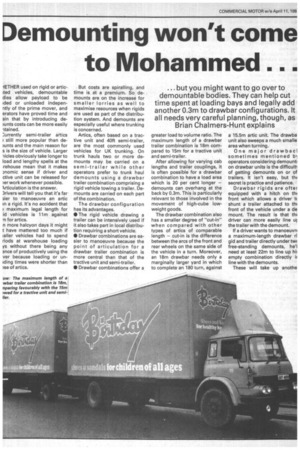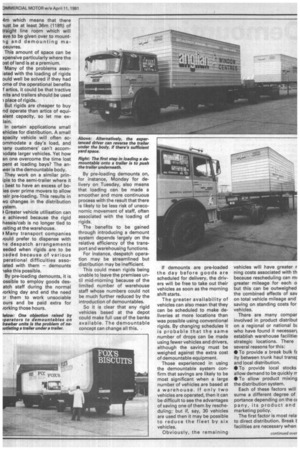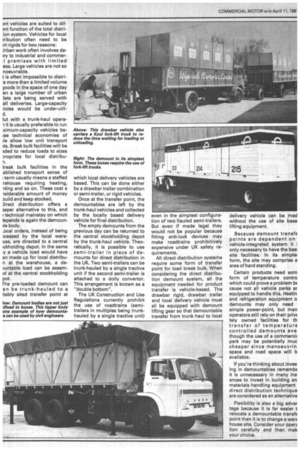Demounting won't come to Mohammed . .
Page 40

Page 41

Page 42

If you've noticed an error in this article please click here to report it so we can fix it.
-IETHER used on rigid or articited vehicles, demountable dies allow payload to be ided or unloaded indepenrgly of the prime mover, and erators have proved time and in that by introducing de)u nts costs can be more easily -gained.
:urrently semi-trailer artics ! still more popular than derunts and the main reason for s is the size of vehicle. Larger iicles obviously take longer to load and lengthy spells at the rehouse mean that it makes )nomic sense if driver and ctive unit can be released for ler work whenever possible. skrticulation is the answer. Myers will tell you that it's far ;ler to manoeuvre an artic in a rigid. It's no accident that
maximum legal length for id vehicles is 11m against Ti for artics.
n more halcyon days it might
t have mattered too much if !eller vehicles had to spend nods at warehouse loading ys without there being any 3nce of productively using the ver because loading or uniding times were shorter than )se of artics.
But costs are spiralling, and time is at a premium. So demounts are on the increase for smaller lorries as well to maximise resources when rigids are used as part of the distribution system. And demounts are especially useful where trunking is concerned.
Artics, often based on a tractive unit and 40ft semi-trailer, are the most commonly used vehicles for UK trunking. On trunk hauls two or more demounts may be carried on a semi-trailer while other operators prefer to trunk haul demounts using a drawbar trailer combination comprising a rigid vehicle towing a trailer. Demounts are carried on each part of the combination.
The drawbar configuration has its advantages.
• The rigid vehicle drawing a trailer can be intensively used if it also takes part in local distribution requiring a short vehicle.
• Drawbar combinations are easier to manoeuvre because the point of articulation for a drawbar trailer combination is more central than that of the tractive unit and semi-trailer.
• Drawbar combinations offer a greater load to volume ratio. The maximum length of a drawbar trailer combination is 18m compared to 15m for a tractive unit and semi-trailer.
After allowing for varying cab lengths and trailer couplings, it is often possible for a drawbar combination to have a load area which is 20 per cent longer — demounts can overhang at the back by 0.3m. This is particularly relevant to those involved in the movement of high-cube lowweight goods.
The drawbar combination also has a smaller degree of "cut-in" when compared with other types of artics of comparable length — cut-in is the difference between the arcs of the front and rear wheels on the same side of the vehicle in a turn. Moreover, an 18m drawbar needs only a marginally larger yard in which to complete an 180 turn, against a 15.5m artic unit. The drawba unit also sweeps a much smalle area when turning.
One major drawbacl sometimes mentioned br, operators considering demount on drawbar units is the difficult, of getting demounts on or of trailers. It isn't easy, but thr secret is practice and patience.
Drawbar rig ids are after equipped with a hitch on thr front which allows a driver tc shunt a trailer attached to thr front of the vehicle under a de mount. The result is that thr driver can more easily line ur the trailer with the demount.
If a driver wants to manoeuvrr a maximum-length drawbar ri gid and trailer directly under b/w free-standing demounts, he'l need at least 22m to line up hi: empty combination directly ir line with the demounts.
These will take up anothe 4m which means that there lust be at least 36m (118ft) of traight line room which will aye to be given over to mountig and demounting maoeuvres.
This amount of space can be xpensive particularly where the ost of land is at a premium.
Many of the problems assoiated with the loading of rigids ould well be solved if they had ome of the operational benefits f artics, it could be that tractive nits and trailers should be used place of rigids.
But rigids are cheaper to buy ,id operate than artics of equialent capacity, so let me exlain.
In certain applications small ehicles for distribution. A small apacity vehicle will often acommodate a day's load, and ,any customers' can't accomiodate larger vehicles. Yet how an one overcome the time lost pent at loading bays? The anvver is the demountable body. They work on a similar priniple to the semi-trailer where it best to have an excess of boles over prime movers to allow leir pre-loading. This results in rya changes in the distribution ystern, I) Greater vehicle utilisation can e achieved because the rigid hassisicab is no longer tied to iaiting at the warehouse.
Many transport companies rould prefer to dispense with he despatch arrangements eeded when rigids are to be aaded because of various perational difficulties assoiated with them — demounts lake this possible.
By pre-loading demounts, it is ossible to employ goods desetch staff during the normal rorking day and end the need air them to work unsociable ours and be paid extra for iorking those hours. By pre-loading demounts on, for instance, Monday for delivery on Tuesday, also means that loading can be made a smoother and more continuous process with the result that there is likely to be less risk of uneconomic movement of staff, often associated with the loading of rigids.
The benefits to be gained through introducing a demount system depends largely on the relative efficiency of the transport and warehousing functions.
For instance, despatch operation may be streamlined but distribution may be inefficient.
This could mean rigids being unable to leave the premises until mid-morning because of the limited number of warehouse staff whose numbers could not be much further reduced by the introduction of demountables.
So it is clear that any rigid vehicles based at the depot could make full use of the banks available. The demountable concept can change all this. . If demounts are pre-loaded the day before goods are scheduled for delivery, the drivers will be free to take out their vehicles as soon as the morning shift starts.
The greater availability of vehicles can also mean that they can be scheduled to make deliveries at more locations than was possible using conventional rigids. By changing schedules it is probable that the same number of drops can be made using fewer vehicles and drivers, although the saving must be weighed against the extra cost of demountable equipment.
Those experienced in using the demountable system confirm that savings are likely to be most significant when a large number of vehicles are based at a warehouse. If only two vehicles are operated, then it can be difficult to see the advantages of saving one of them by rescheduling; but if, say, 30 vehicles are used then it may be possible to reduce the fleet by six vehicles.
Obviously, the remaining vehicles will have greater r fling costs associated with th because rescheduling can mi greater mileage for each o but this can be outweighed the combined effects of say on total vehicle mileage and saving on standing costs for vehicles.
There are many compar involved in product distribut on a regional or national bi who have found it necessar\ establish warehouse facilitiel strategic locations. There several reasons for this: • To provide a break bulk fE ity between trunk haul transi and local distribution.
• To provide local stocks allow demand to be quickly n
• To allow product mixing the distribution system.
Each of these factors will sume a different degree of portance depending on the ct pany, its product and marketing policy.
The first factor is most rela to direct distribution. Break t facilities are necessary when 3nt vehicles are suited to difant function of the total distriion system. Vehicles for local tribution often need to be ;rt rigids for two reasons: kban work often involves delry to industrial and commerI premises with limited ess. Large vehicles are not so noeuvrable, t is often impossible to distri:e more than a limited volume poods in the space of one day en a large number of urban Jets are being served with all deliveries. Large-capacity licles would be under-utild.
lut with a trunk-haul opera1 it is usually preferable to run ximum-capacity vehicles bese technical economies of Ile allow low unit transport As. Break bulk facilities will be 3ded to reduce loads to sizes 3ropriate for local distribui.
3reak bulk facilities in the ablished transport sense of term usually means a staffed rehouse requiring heating, iting and so on. These cost a 1siderable amount of money Duild and keep stocked.
)irect distribution offers a aper alternative to this, and technical mainstay on which lepends is again the demoun;le body.
_ocal orders, instead of being )cessed by the local wareuse, are directed to a central ickholding depot. In the same y a vehicle load would have en made up for local distribun at the warehouse, a de)untable load can be assemxd at the central stockholding pot.
ihe pre-loaded demount can en be trunk-hauled to a itably sited transfer point at which local delivery vehicles are based. This can be done either by a drawbar trailer combination or semi-trailer, or rigid vehicles.
Once at the transfer point, the demountables are left by the trunk-haul vehicles and collected by the locally based delivery vehicle for final distribution.
The empty demounts from the previous day can be returned to the central stockholding depot by the trunk-haul vehicle. Theoretically, it is possible to use semi-trailer in place of demounts for direct distribution in the UK. Two semi-trailers can be trunk-hauled by a single tractive unit if the second semi-trailer is attached to a dolly convertor. This arrangement is known as a "double bottom".
The UK Construction and Use Regulations currently prohibit the use of roadtrains (semitrailers in multiples being trunkhauled by a single tractive unit)
even in the simplest configuration of two hauled semi-trailers. But even if made legal they would not be popular because fitting anti-lock devices may make roadtrains prohibitively expensive under UK safety requirements.
All direct distribution systems require some form of transfer point for load break bulk. When considering the direct distribution demount system, all the equipment needed for product transfer is vehicle-based. The drawbar rigid, drawbar trailer and local delivery vehicle must all be equipped with demount lifting gear so that demountable transfer from trunk haul to local delivery vehicle can be mad without the use of site base lifting equipment.
Because demount transfE points are dependent on vehicle-integrated system it i only necessary to have the basi site facilities. In its simple: form, the site may comprise a area of hard standing.
Certain products need som form of temperature contro which could prove a problem IDE cause not all vehicle parks ar equipped to handle this. Heatin and refrigeration equipment o demounts may only need simple power-point, but man operators still rely on their prive tely owned facilities for th transfer of temperature controlled demounts eve though the use of a cornmercie park may be potentially muc cheaper since manoeuvrin space and road space will b available.
If you're thinking about inves. ing in demountables remembE it is unnecessary in many ins. ances to invest in building an materials handling equipment direct distribution technique are considered as an alternative
Flexibility is also a big advar tage because it is far easier t relocate a demountable transfE point than it is to change a ware house site. Consider your opera tion carefully and then mak your choice.




































































































